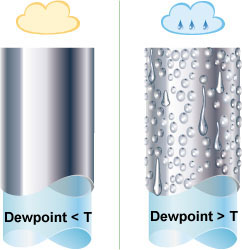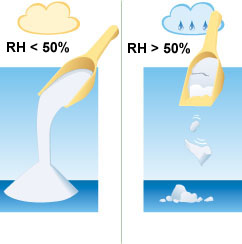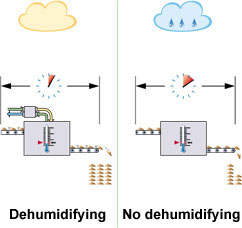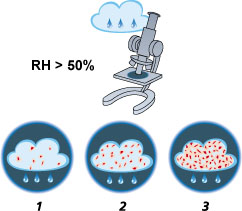Why Dehumidify Intrduction
In the following sections we will explain the basics of sorption dehumidifying. Why you need it, how it works and how you estimate your need for dehumidifying.

CORROSION
Iron and steel will not rust if the air in contact with the surface has a humidity below 50% relative humidity (RH). Dehumidification is often a better and less expensive way to protect investments than painting. Objects that are protected by dehumidification are for example bridges, power stations , boats (during refitl) and offshore constructions.

CONDENSATION
Moisture will not condensate on a surface if the air in contact with it has a dew-point lower than the surface temperature. Condensation can lead to many problems such as corrosion or short-circuit in electrical systems.

ICE FORMATION
Ice will not form on a surface if the air in contact with it has a dew-point lower than the surface temperature. Ice formation is a problem in for example cold storages where it will cause a lower efficiency in the cooling machinery. Dehumidification will keep the ice away.

HANDLING OF HYGROSCOPIC MATERIALS
The quality of dry drugs, dry food, hard candy and other hygroscopic materials can only be maintained through production to the consumer if it is kept in contact with air at a low relative humidity. If your products form lumps, degrade quickly, or get sticky you should consider dehumidification. Most materials demand dew-points so low that they can only be achieved by sorption dehumidifiers.

DRYING BUILDINGS
When removing moisture from a building, whether it is a new building or a building with water damage, the most effective way is to use sorption dehumidifying. Heating will only move the moisture to another part of the building, heating in combination with outdoor ventilation will create high energy costs. With sorption dehumidifying the moisture is removed from the building in a very energy efficient way.

MOULD
Mould and fungus formation is prevented if the surrounding air is kept below 70%RH. This is important in many situations, for example in storage of wooden products. In houses designed with a crawl space it is often necessary to use a dehumidifier to keep mould and fungus from forming.

ODOURS
Unpleasant odours, will be significantly reduced if the relative humidity is kept below 50%RH. For example , in sewage stations the odours can be controlled by installing a dehumidifier.

PRODUCT DRYING AND COOLING
When drying and cooling products a low relative humidity is essential for a fast process. If the products to be dried are sensitive to high temperature, the low relative humidity can only be obtained with dehumidification. In cooling processes dehumidification allows for a lower temperature without condensation. The result is faster cooling and money saved.

ELECTRONICS
The characteristics of electronic products are changed at high relative humidity.

BACTERIA
Bacteria need humidity to survive and multiply. Often the humidity required for bacteria to multiply is found on hygroscopic materials. If the surrounding air is held below 50% relative humidity most bacteria will not find a suitable environment to multiply.